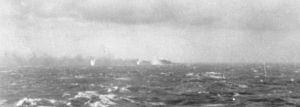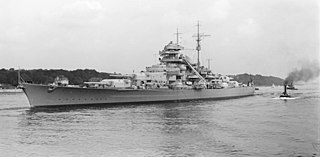
Bismarck was the first of two Bismarck-class battleships built for Nazi Germany's Kriegsmarine. Named after Chancellor Otto von Bismarck, the ship was laid down at the Blohm & Voss shipyard in Hamburg in July 1936 and launched in February 1939. Work was completed in August 1940, when she was commissioned into the German fleet. Bismarck and her sister ship Tirpitz were the largest battleships ever built by Germany, and two of the largest built by any European power.

Yamato was the lead ship of her class of battleships built for the Imperial Japanese Navy (IJN) shortly before World War II. She and her sister ship, Musashi, were the heaviest and most powerfully armed battleships ever constructed, displacing nearly 72,000 tonnes at full load and armed with nine 46 cm (18.1 in) Type 94 main guns, which were the largest guns ever mounted on a warship.
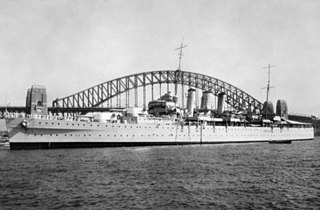
HMS Dorsetshire was a County-class heavy cruiser of the British Royal Navy, named after the English county, now usually known as Dorset. The ship was a member of the Norfolk sub-class, of which Norfolk was the only other unit; the County class comprised a further eleven ships in two other sub-classes. Dorsetshire was built at the Portsmouth Dockyard; her keel was laid in September 1927, she was launched in January 1929, and was completed in September 1930. Dorsetshire was armed with a main battery of eight 8 in (203 mm) guns, and had a top speed of 31.5 knots.
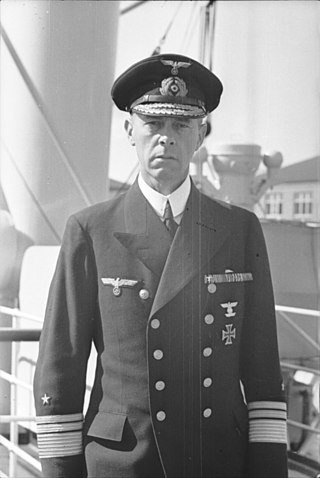
Operation Rheinübung was the last sortie into the Atlantic by the new German battleship Bismarck and heavy cruiser Prinz Eugen on 18–27 May 1941, during World War II. This operation aimed to block Allied shipping to the United Kingdom as the previously successful Operation Berlin had done. After Bismarck had sunk HMS Hood during the Battle of the Denmark Strait, it culminated with the sinking of the Bismarck, while Prinz Eugen escaped to port in occupied France. From that point on, Germans would rely only on U-boats to wage the Battle of the Atlantic.

Otto Ernst Lindemann was a German Kapitän zur See. He was the only commander of the battleship Bismarck during its eight months of service in World War II.

HMS Norfolk was a County-class heavy cruiser of the Royal Navy. The ship was the Lead ship of the Norfolk-subclass of which only two were built: Norfolk and Dorsetshire. She served throughout the Second World War. During 1939-41 she operated in the Atlantic against German raiders and blockade runners. In March 1940 she was damaged by German dive bomber in the anchorage of Scapa Flow.

The King George V-class battleships were the most modern British battleships in commission during the Second World War. Five ships of this class were built: HMS King George V, HMS Prince of Wales (1941), HMS Duke of York (1941), HMS Anson (1942) and HMS Howe (1942). The names honoured King George V, and his sons, Edward VIII, who had been Prince of Wales, and George VI who was Duke of York before ascending to the throne; the final two ships of the class were named after prominent 18th century admirals of the Royal Navy.

HMS King George V was the lead ship of the five British King George V-class battleships of the Royal Navy. Laid down in 1937 and commissioned in 1940, King George V operated during the Second World War in all three major naval theatres of war, the Atlantic, Mediterranean and Pacific, as part of the British Home Fleet and Pacific Fleets. In May 1941, along with HMS Rodney, King George V was involved in the hunt for and pursuit of the German battleship Bismarck, eventually inflicting severe damage which led to the German vessel's sinking. On 1 May 1942 the destroyer HMS Punjabi sank after a collision with King George V in foggy conditions. King George V took part in Operation Husky and bombarded the island of Levanzo and the port of Trapani. She also escorted part of the surrendered Italian Fleet, which included the battleships Andrea Doria and Duilio, to Malta. In 1945 King George V took part in operations against the Japanese in the Pacific.

HMS Prince of Wales was a King George V-class battleship of the Royal Navy that was built at the Cammell Laird shipyard in Birkenhead. Despite being sunk less than a year after she was commissioned, Prince of Wales had an extensive battle history, first seeing action in August 1940 while still being outfitted in her drydock, when she was attacked and damaged by German aircraft. In her brief career, she was involved in several key actions of the Second World War, including the May 1941 Battle of the Denmark Strait where she scored three hits on the German battleship Bismarck, forcing Bismarck to abandon her raiding mission and head to port for repairs. Prince of Wales later escorted one of the Malta convoys in the Mediterranean, during which she was attacked by Italian aircraft. In her final action, she attempted to intercept Japanese troop convoys off the coast of Malaya as part of Force Z when she was sunk by Japanese aircraft on 10 December 1941, two days after the attack on Pearl Harbor.
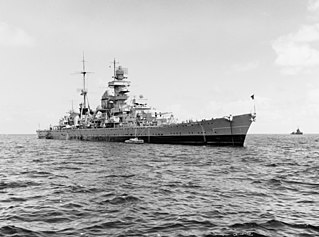
Prinz Eugen was an Admiral Hipper-class heavy cruiser, the third of a class of five vessels. She served with Nazi Germany's Kriegsmarine during World War II. The ship was laid down in April 1936, launched in August 1938, and entered service after the outbreak of war, in August 1940. She was named after Prince Eugene of Savoy, a distinguished 18th-century general in the service of the Holy Roman Empire. She was armed with a main battery of eight 20.3 cm (8 in) guns and, although nominally under the 10,000-long-ton (10,160 t) limit set by the Anglo-German Naval Agreement, actually displaced over 16,000 long tons (16,257 t).

The Battle of the Denmark Strait was a naval engagement in the Second World War, which took place on 24 May 1941 between ships of the Royal Navy and the Kriegsmarine. The British battleship HMS Prince of Wales and the battlecruiser HMS Hood fought the German battleship Bismarck and the heavy cruiser Prinz Eugen, which were attempting to break out into the North Atlantic to attack Allied merchant shipping through the Denmark Strait between Greenland and Iceland.

Sink the Bismarck! is a 1960 black-and-white CinemaScope British war film based on the 1959 book The Last Nine Days of the Bismarck by C. S. Forester. It stars Kenneth More and Dana Wynter and was directed by Lewis Gilbert. To date, it is the only film made that deals directly with the operations, chase and sinking of the battleship Bismarck by the Royal Navy during the Second World War. Although war films were common in the 1960s, Sink the Bismarck! was seen as something of an anomaly, with much of its time devoted to the "unsung back-room planners as much as on the combatants themselves". Its historical accuracy, in particular, met with much praise despite a number of inconsistencies.

The Scharnhorst class was a class of German battleships built immediately prior to World War II. The first capital ships of Nazi Germany's Kriegsmarine, it comprised two vessels: Scharnhorst and Gneisenau. Scharnhorst was launched first, and is considered to be the lead ship by some sources; they are also referred to as the Gneisenau class in some other sources, as Gneisenau was the first to be laid down and commissioned. They marked the beginning of German naval rearmament after the Treaty of Versailles. The ships were armed with nine 28 cm (11 in) SK C/34 guns in three triple turrets; plans to replace these with six 38 cm (15 in) SK C/34 guns in twin turrets were never realized.

German submarine U-74 was a Type VIIB U-boat of Nazi Germany's Kriegsmarine during World War II.

Adalbert Schneider was the First Gunnery Officer on board the battleship Bismarck, and was awarded the Knight's Cross of the Iron Cross for the sinking of HMS Hood on 24 May 1941 in the Battle of the Denmark Strait. Less than a week later, on 27 May 1941, Schneider and the majority of Bismarck's crew were killed in action during Bismarck's last battle.

The Bismarck class was a pair of fast battleships built for Nazi Germany's Kriegsmarine shortly before the outbreak of World War II. The ships were the largest and most powerful warships built for the Kriegsmarine; displacing more than 41,000 metric tons normally, they were armed with a battery of eight 38 cm (15 in) guns and were capable of a top speed of 30 knots. Bismarck was laid down in July 1936 and completed in September 1940, while the keel of her sister ship, Tirpitz, was laid in October 1936 and work finished in February 1941. The ships were ordered in response to the French Richelieu-class battleships, themselves laid down in response to the Italian Littorio-class battleships. The Bismarck-class was designed with the traditional role of engaging enemy battleships in home waters in mind, though the Oberkommando der Marine envisioned employing the ships as long-range commerce raiders against British shipping in the Atlantic Ocean. As such, their design represented the strategic confusion that dominated German naval construction in the 1930s.

Scharnhorst was a German capital ship, alternatively described as a battleship or battlecruiser, of Nazi Germany's Kriegsmarine. She was the lead ship of her class, which included her sister ship Gneisenau. The ship was built at the Kriegsmarinewerft dockyard in Wilhelmshaven; she was laid down on 15 June 1935 and launched a year and four months later on 3 October 1936. Completed in January 1939, the ship was armed with a main battery of nine 28 cm (11 in) C/34 guns in three triple turrets. Plans to replace these weapons with six 38 cm (15 in) SK C/34 guns in twin turrets were never carried out.

Gneisenau was a German capital ship, alternatively described as a battleship and battlecruiser, in Nazi Germany's Kriegsmarine. She was the second vessel of her class, which included her sister ship, Scharnhorst. The ship was built at the Deutsche Werke dockyard in Kiel; she was laid down on 6 May 1935 and launched on 8 December 1936. Her outfitting was completed in May 1938: she was armed with a main battery of nine 28 cm (11 in) C/34 guns in three triple turrets. At one point after construction had started, a plan had been approved to replace these weapons with six 38 cm (15 in) SK C/34 guns in twin turrets, but when it was realized that this would involve a lot of redesign, that plan was abandoned, and construction continued with the originally planned lower-calibre guns. The upgrade had been intended to be completed in the winter of 1940–41, but instead, due to the outbreak of World War II, that work was stopped.

Johann Günther Lütjens was a German admiral whose military service spanned more than 30 years and two world wars. Lütjens is best known for his actions during World War II and his command of the battleship Bismarck during her foray into the Atlantic Ocean in 1941. He was killed in action during the last battle of the battleship Bismarck.

Tirpitz was the second of two Bismarck-class battleships built for Nazi Germany's Kriegsmarine (navy) prior to and during the Second World War. Named after Grand Admiral Alfred von Tirpitz, the architect of the Kaiserliche Marine, the ship was laid down at the Kriegsmarinewerft in Wilhelmshaven in November 1936 and her hull was launched two and a half years later. Work was completed in February 1941, when she was commissioned into the German fleet. Like her sister ship, Bismarck, Tirpitz was armed with a main battery of eight 38-centimetre (15 in) guns in four twin turrets. After a series of wartime modifications she was 2000 tonnes heavier than Bismarck, making her the heaviest battleship ever built by a European navy.
